Page 113 of 396
1133-5. Opening and closing the windows
3
Operation of each component
Power windows
The power windows can be opened and closed using the switches.
Operating the switch moves the windows as follows:
Closing
Opening
One-touch opening
(driver’s
window only)
*
*
: To stop the window partway, oper-
ate the switch in the opposite direc-
tion.
Press the switch down to lock the
passenger window switches.
Use this switch to prevent children
from accidentally opening or clos-
ing a passenger window.
Opening and closing procedures
1
2
3
Window lock switch
Page 114 of 396
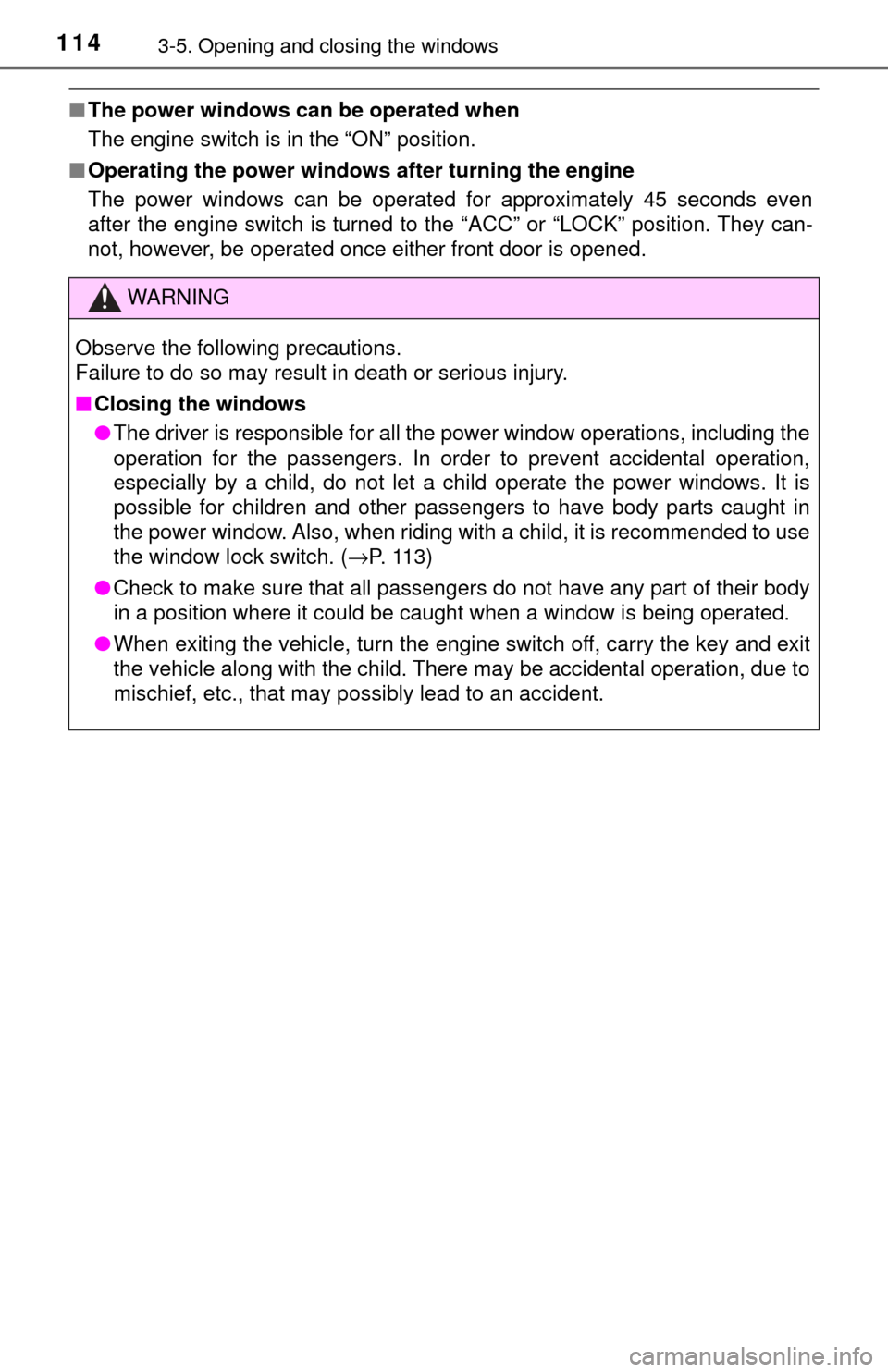
1143-5. Opening and closing the windows
■The power windows can be operated when
The engine switch is in the “ON” position.
■ Operating the power windows after turning the engine
The power windows can be operated for approximately 45 seconds even
after the engine switch is turned to the “ACC” or “LOCK” position. They can-
not, however, be operated once either front door is opened.
WARNING
Observe the following precautions.
Failure to do so may result in death or serious injury.
■ Closing the windows
● The driver is responsible for all the power window operations, including the
operation for the passengers. In order to prevent accidental operation,
especially by a child, do not let a child operate the power windows. It is
possible for children and other passengers to have body parts caught in
the power window. Also, when riding with a child, it is recommended to use
the window lock switch. ( →P. 113)
● Check to make sure that all passengers do not have any part of their body
in a position where it could be caught when a window is being operated.
● When exiting the vehicle, turn the engine switch off, carry the key and exit
the vehicle along with the child. There may be accidental operation, due to
mischief, etc., that may possibly lead to an accident.
Page 246 of 396
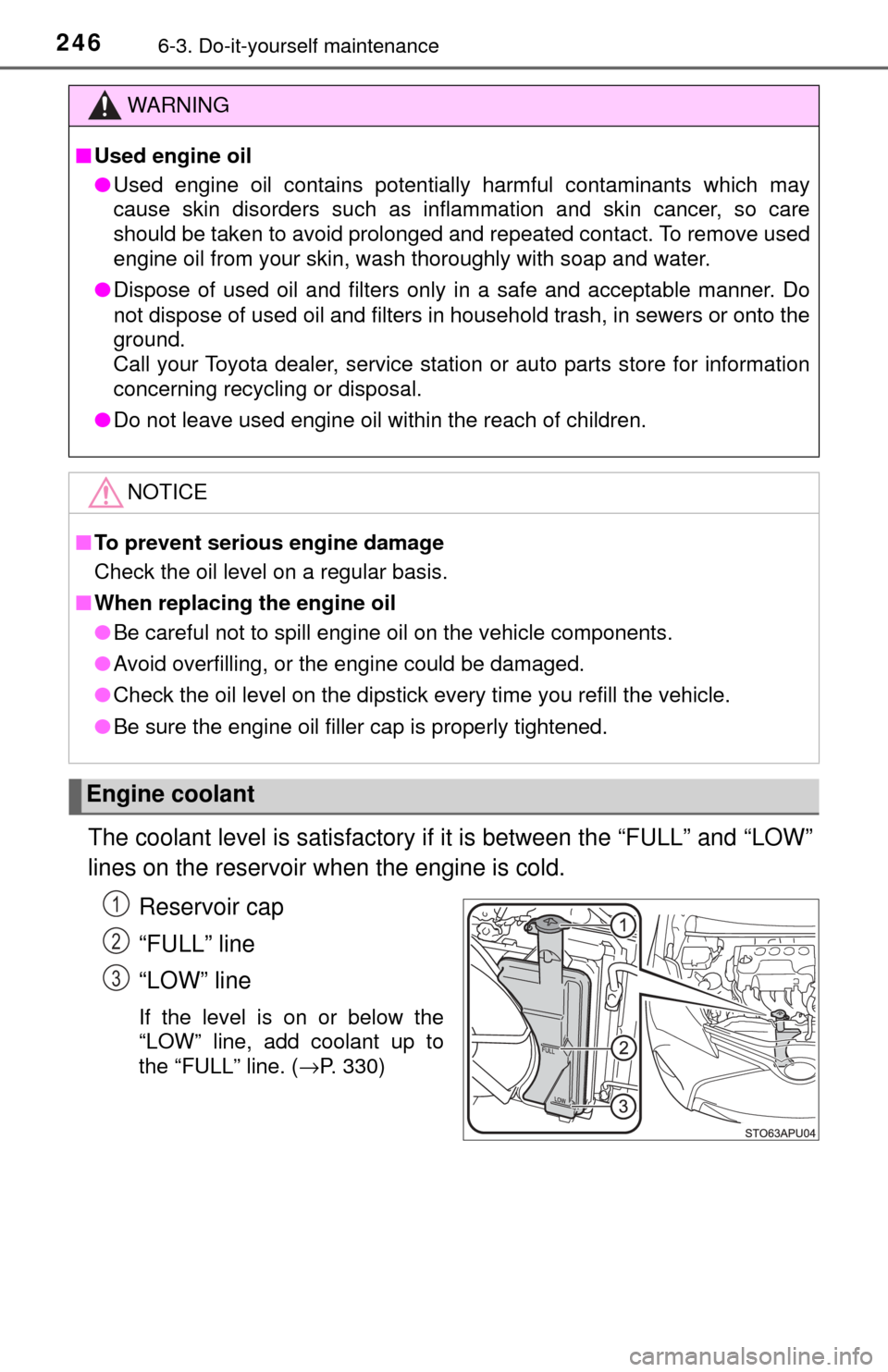
2466-3. Do-it-yourself maintenance
The coolant level is satisfactory if it is between the “FULL” and “LOW”
lines on the reservoir when the engine is cold.Reservoir cap
“FULL” line
“LOW” line
If the level is on or below the
“LOW” line, add coolant up to
the “FULL” line. ( →P. 330)
WARNING
■Used engine oil
● Used engine oil contains potentially harmful contaminants which may
cause skin disorders such as inflammation and skin cancer, so care
should be taken to avoid prolonged and repeated contact. To remove used
engine oil from your skin, wash thoroughly with soap and water.
● Dispose of used oil and filters only in a safe and acceptable manner. Do
not dispose of used oil and filters in household trash, in sewers or onto the
ground.
Call your Toyota dealer, service station or auto parts store for information
concerning recycling or disposal.
● Do not leave used engine oil within the reach of children.
NOTICE
■To prevent serious engine damage
Check the oil level on a regular basis.
■ When replacing the engine oil
● Be careful not to spill engine oil on the vehicle components.
● Avoid overfilling, or the engine could be damaged.
● Check the oil level on the dipstick every time you refill the vehicle.
● Be sure the engine oil filler cap is properly tightened.
Engine coolant
1
2
3
Page 250 of 396
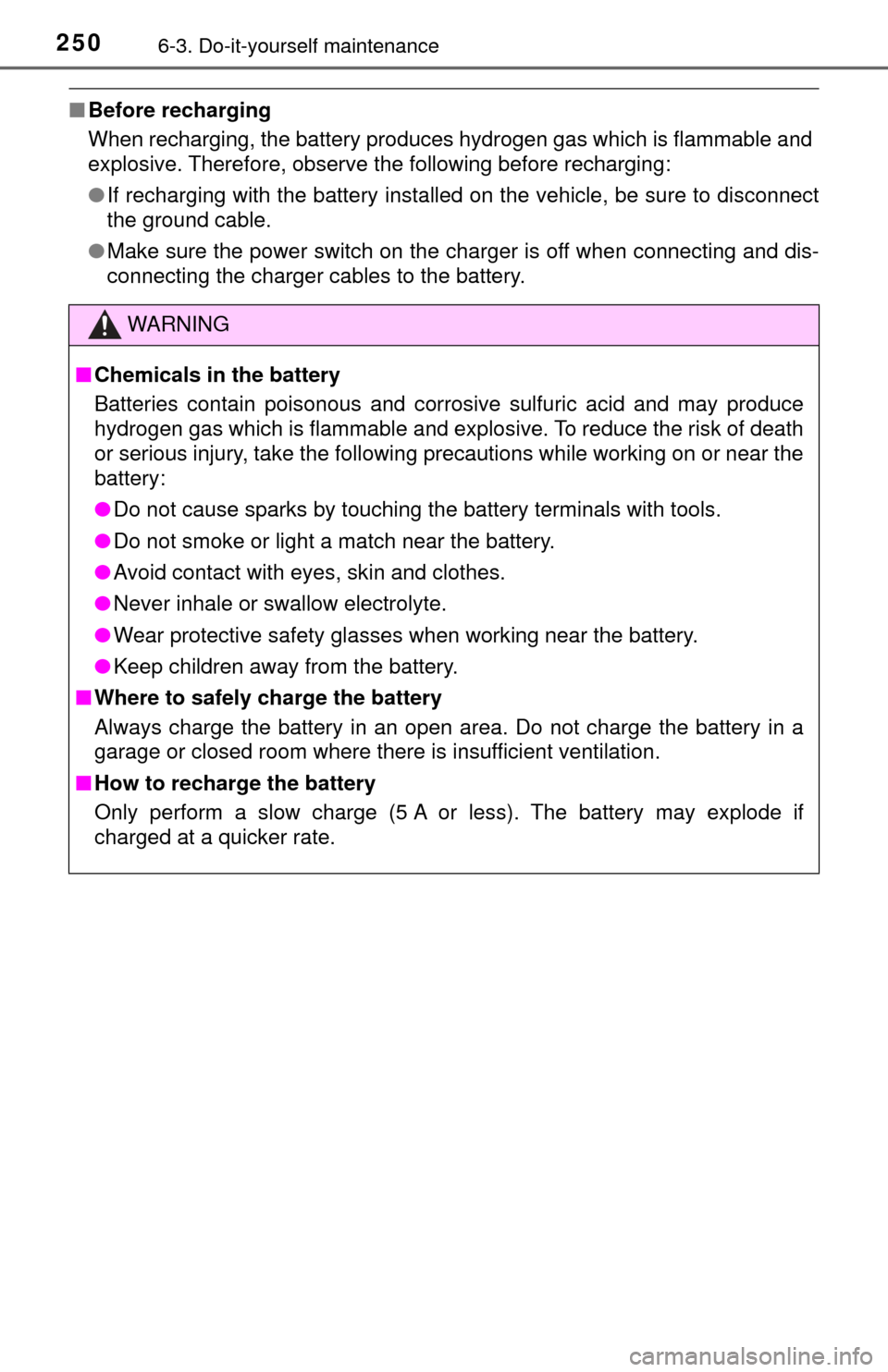
2506-3. Do-it-yourself maintenance
■Before recharging
When recharging, the battery produces hydrogen gas which is flammable and
explosive. Therefore, observe the following before recharging:
●If recharging with the battery installed on the vehicle, be sure to disconnect
the ground cable.
● Make sure the power switch on the charger is off when connecting and dis-
connecting the charger cables to the battery.
WARNING
■Chemicals in the battery
Batteries contain poisonous and corrosive sulfuric acid and may produce
hydrogen gas which is flammable and explosive. To reduce the risk of death
or serious injury, take the following precautions while working on or near the
battery:
● Do not cause sparks by touching the battery terminals with tools.
● Do not smoke or light a match near the battery.
● Avoid contact with eyes, skin and clothes.
● Never inhale or swallow electrolyte.
● Wear protective safety glasses when working near the battery.
● Keep children away from the battery.
■ Where to safely charge the battery
Always charge the battery in an open area. Do not charge the battery in a
garage or closed room where there is insufficient ventilation.
■ How to recharge the battery
Only perform a slow charge (5 A or less). The battery may explode if
charged at a quicker rate.
Page 272 of 396
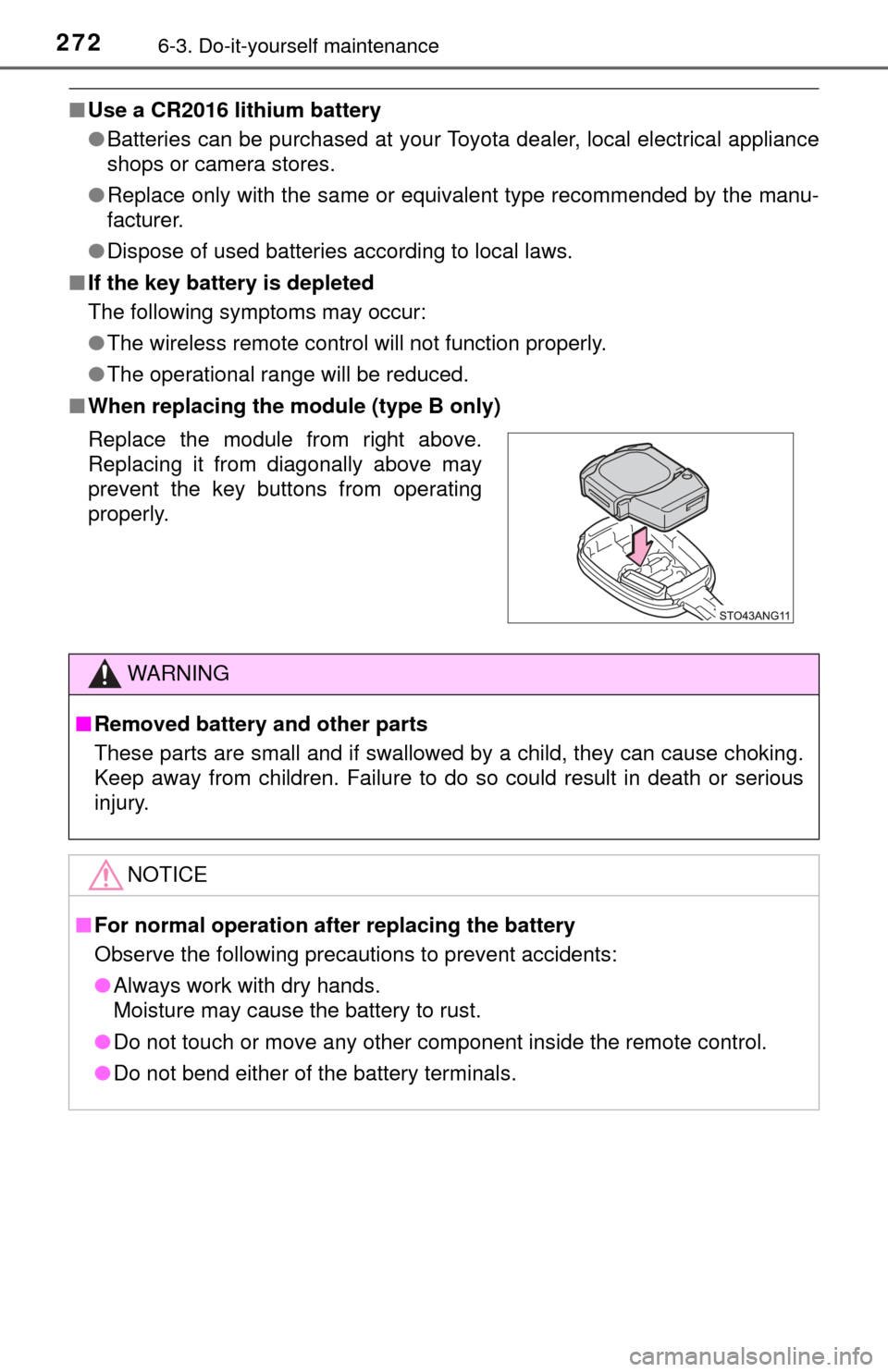
2726-3. Do-it-yourself maintenance
■Use a CR2016 lithium battery
●Batteries can be purchased at your Toyota dealer, local electrical appliance
shops or camera stores.
● Replace only with the same or equivalent type recommended by the manu-
facturer.
● Dispose of used batteries according to local laws.
■ If the key battery is depleted
The following symptoms may occur:
●The wireless remote control will not function properly.
● The operational range will be reduced.
■ When replacing the module (type B only)
Replace the module from right above.
Replacing it from diagonally above may
prevent the key buttons from operating
properly.
WARNING
■Removed battery and other parts
These parts are small and if swallowed by a child, they can cause choking.
Keep away from children. Failure to do so could result in death or serious
injury.
NOTICE
■For normal operation after replacing the battery
Observe the following precautions to prevent accidents:
● Always work with dry hands.
Moisture may cause the battery to rust.
● Do not touch or move any other component inside the remote control.
● Do not bend either of the battery terminals.
Page 329 of 396

3297-2. Steps to take in an emergency
7
When trouble arises
WARNING
■Avoiding battery fires or explosions
Observe the following precautions to prevent accidentally igniting the flam-
mable gas that may be emitted from the battery:
● Make sure each jumper cable is connected to the correct terminal and that
it is not unintentionally in contact with anything other than the intended ter-
minal.
● Do not allow the + and - clamps of the jumper cables to come into contact
with each other.
● Do not smoke, use matches, cigarette lighters or allow open flame near
the battery.
■ Battery precautions
The battery contains poisonous and corrosive acidic electrolyte, while
related parts contain lead and lead compounds. Observe the following pre-
cautions when handling the battery:
● When working with the battery, always wear safety glasses and take care
not to allow any battery fluids (acid) to come into contact with skin, clothing
or the vehicle body.
● Do not lean over the battery.
● In the event that battery fluid comes into contact with the skin or eyes,
immediately wash the affected area with water and seek medical attention.
Place a wet sponge or cloth over the affected area until medical attention
can be received.
● Always wash your hands after handling the battery support, terminals, an\
d
other battery-related parts.
● Do not allow children near the battery.
■ To prevent damage to the vehicle
Do not pull- or push-start the vehicle as the three-way catalytic conver\
ter
may overheat and become a fire hazard.
NOTICE
■When handling jumper cables
When connecting the jumper cables, ensure that they do not become entan-
gled in the cooling fans or engine drive belt.
Page 382 of 396
382What to do if... (Troubleshooting)
What to do if... (Troubleshooting)
●If you lose your keys, new genuine keys can be made by your Toyota
dealer. (→P. 86)
●Is the key battery weak or depleted? ( →P. 270)
●The function may not operate properly due to the condition of the radio
wave. (→P. 87)
●Is the child-protector lock set?
The rear door cannot be opened from inside the vehicle when the lock is
set. Open the rear door from outside and then unlock the child-protector
lock. (→P. 92)
If you have a problem, check the following before contacting
your Toyota dealer.
The doors cannot be locked, unlocked, opened or closed
You lose your keys
The doors cannot be locked or unlocked
The rear door cannot be opened
Page 385 of 396
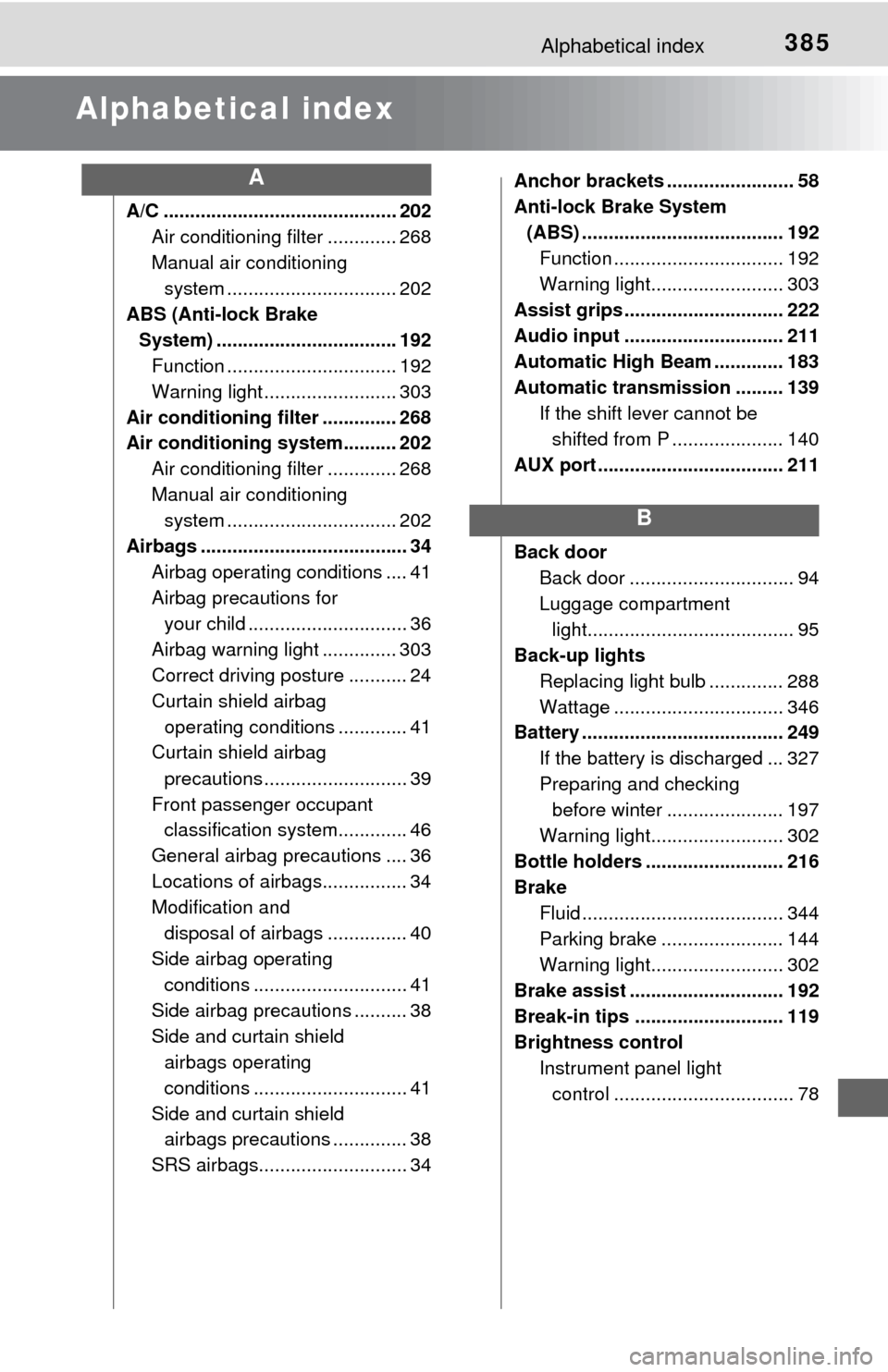
385Alphabetical index
Alphabetical index
A/C ............................................ 202Air conditioning filter ............. 268
Manual air conditioning system ......... ....................... 202
ABS (Anti-lock Brake System) .................................. 192 Function ................................ 192
Warning light ......................... 303
Air conditioning filter .............. 268
Air conditioning system.......... 202 Air conditioning filter ............. 268
Manual air conditioning system ......... ....................... 202
Airbags ....................................... 34 Airbag operating conditions .... 41
Airbag precautions for your child .............................. 36
Airbag warning light .............. 303
Correct driving posture ........... 24
Curtain shield airbag operating conditions ............. 41
Curtain shield airbag
precautions ........................... 39
Front passenger occupant classification syst em............. 46
General airbag precautions .... 36
Locations of airbags................ 34
Modification and disposal of airbags ............... 40
Side airbag operating conditions ............................. 41
Side airbag precautions .......... 38
Side and curtain shield airbags operating
conditions ............................. 41
Side and curtain shield airbags precautions .............. 38
SRS airbags............................ 34 Anchor brackets ........................ 58
Anti-lock Brake System
(ABS) ...................................... 192
Function ................................ 192
Warning light......................... 303
Assist grips .............................. 222
Audio input .............................. 211
Automatic High Beam ............. 183
Automatic transmission ......... 139 If the shift lever cannot be
shifted from P ..................... 140
AUX port ................................... 211
Back door Back door ............................... 94
Luggage compartment
light....................................... 95
Back-up lights
Replacing light bulb .............. 288
Wattage ................................ 346
Battery ...................................... 249
If the battery is discharged ... 327
Preparing and checking before winter ...................... 197
Warning light......................... 302
Bottle holders .......................... 216
Brake Fluid ...................................... 344
Parking brake ....................... 144
Warning light......................... 302
Brake assist ............................. 192
Break-in tips ............................ 119
Brightness control Instrument panel light control .................................. 78
A
B